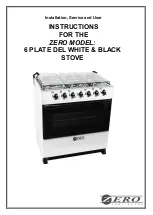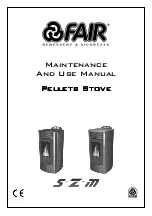
If smoke is seen establish the point of leakage and carry out remedial work to correct
any faults.
•
After completing the remedial work repeat the testing procedure until no major leakage
or fault is apparent. Remove the closures at the top and bottom of the chimney.
Smoke Test 2: Appliance Draw Test
•
Ensure appliance is not alight and all doors and windows in the room are closed.
•
If there is a solid fuel appliance or open fire appliance fitted at the base or the bottom
of the chimney, heat the inside of the Appliance/Fireplace chamber with a blow Lamp,
gas stove or similar device for approx 10 minutes, a longer warming up time may be
needed with wet or cold flues. This will establish a flue draw to stimulate real
conditions. It should be realised that neither of these methods create the same
temperatures or volume of hot gases that would normally be created whilst the
appliance is in use. If the flue is to be used with a gas burning appliance, the smoke
test should be carried out before the fire is fitted and the flue warmed with a blow lamp
for only 5 minutes, or longer if the flue is cold.
•
For testing flues to be used with a solid fuel appliance place one smoke pellet with a
minimum burn time of 60 seconds producing 15 Mtr
3
of smoke on a flat surface that
cannot be harmed by heat in the opening at the base of the flue or in the appliance if it
is fitted. Always follow the pellet manufacturer’s safety instructions.
•
Ignite pellet and open all vents to stove or fireplace opening. Close the door to the
stove unless these can be correctly operated with the fire doors open.
•
For the first 30 seconds visually inspect that all smoke remains in the appliance or
fireplace opening and ensure that none of the smoke enters the room. Open a window
and check if smoke speeds up or is drawn quicker into the chimney. If either of these
two scenarios are noticed then there is insufficient ventilation, the appliance must be
closed down and further ventilation must be provided.
•
After checking internally go outside whilst pellet is still burning and observe the
smoke exiting the chimney. Ensure smoke is only exiting from correct chimney. If its
leaking from any brick work or any other chimney close the appliance or fireplace
down and attend to remedial repair prior to smoke testing again.
For complete peace of mind it is recommended that a Carbon Monoxide detector approved
to BS EN 50291:2001 is fitted in the same room as the stove. This detector should be fitted
in accordance with the manufacturers instructions. Carbon Monoxide is produced by the
incomplete combustion of fuels, it is extremely harmful and without a detector it is
impossible to detect as it has no colour, odour or taste.
12
Stove Installation Continued.














































